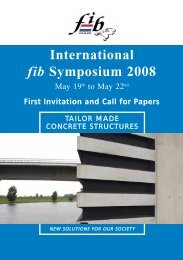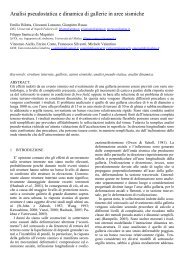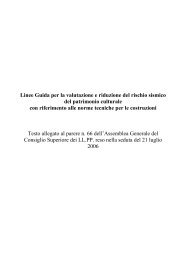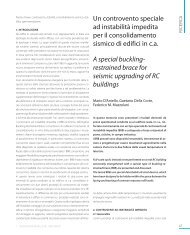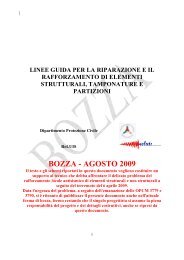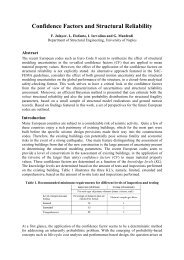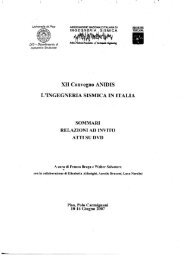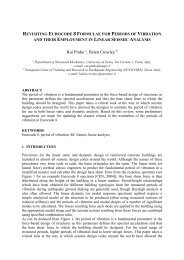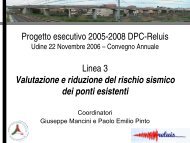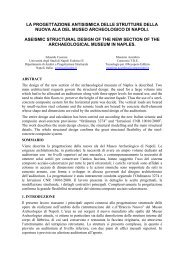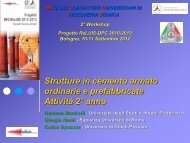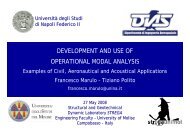Flexural Strength of FRP-Confined RC Columns - ReLUIS
Flexural Strength of FRP-Confined RC Columns - ReLUIS
Flexural Strength of FRP-Confined RC Columns - ReLUIS
You also want an ePaper? Increase the reach of your titles
YUMPU automatically turns print PDFs into web optimized ePapers that Google loves.
Fig. 7. Longitudinal strain <strong>of</strong> the bottom specimen over time (testing device n.1).Fig. 8. Longitudinal strain <strong>of</strong> the bottom specimen over time (testing device n.2).5. CONCLUSIONSIn this paper an experimental study on the creep behaviour <strong>of</strong> C<strong>FRP</strong> pultruded laminates is presented. Inparticular several creep tests have being performed for different stress values at a constant temperature.7
Experimental data relative to the first hours show a limited longitudinal strain variations for the testedspecimens, revealing a negligible primary creep phase.These data confirm the efficacy <strong>of</strong> carbon fibers in limiting the primary creep strains <strong>of</strong> C<strong>FRP</strong> laminates,characterized by high longitudinal Young modulus and high fiber volume fraction, as well known in literature.The subsequent records for testing device n.1 have highlighted a maximum strain variation after about thirtydays [13], starting from the reference time instant t = 28500 s (≈ 8 h), as reported in Table 4. This representsthe assessment time <strong>of</strong> the data acquisition system.Table 4. Maximum longitudinal strain variation (testing device n.1).Specimen strain gage με i με Δε/ε i(t = 28500 s) (t = 2824200 s) [%]TopMiddleBottom1 563 628 -2 493 473 -3 530 502 -4 505 510 -5 826 838 1.456 915 926 1.207 842 850 0.958 895 911 1.799 1072 1085 1.2110 1054 1077 2.1811 1090 1106 1.4712 1029 1046 1.65The average percent longitudinal strain variations for the middle and the bottom specimens are equal to1.35% and 1.63%, respectively. With reference to the top sample, its strain values, being smaller than theothers, are affected by higher measurement errors, and then it is not possible to evaluate with high precisionthe strain variations.The experimental data recorded until time t = 11446200 s (≈ 133 d) have shown any further relevantincreases <strong>of</strong> the longitudinal strains for all the specimens <strong>of</strong> testing device n.1.With reference to the bottom specimen <strong>of</strong> the testing device n.2, the maximum strain variations with respectto reference time instant, t = 0 s, have been recorded at the time instant t = 6552000 s (≈ 76 d), whoseaverage value is equal to 1.93% (Table 5).Table 5. Maximum longitudinal strain variation (testing device n.2).Specimen strain gage με i με Δε/ε i(t = 0 s) (t = 6552000 s) [%]Bottom21 2537 2581 1.7322 2294 2343 2.14Starting from the above experimental results, the viscous behaviour seems to be depleted, due to the creeprate being negligible.They would confirm that the C<strong>FRP</strong> pultruded laminates with high longitudinal Young modulus and high fibervolume fraction highlight limited creep strains.The data are still being acquired in order to verify the effective attenuation <strong>of</strong> creep phenomena.REFERENCES1. ACI Committee 440, Guide for the design and construction <strong>of</strong> externally bonded <strong>FRP</strong> systems forstrengthening concrete structures, 2000.2. CEB-FIP, Externally bonded <strong>FRP</strong> reinforcement for <strong>RC</strong> structures, 2001.3. CNR-DT 200/2004, Istruzioni per la Progettazione, l’Esecuzione ed il Controllo di Interventi diConsolidamento Statico mediante l’utilizzo di Compositi Fibrorinforzati - Materiali, strutture in c.a. e inc.a.p., strutture murarie, 2004 (translated in English, 2005).8
4. Barbero E., Harris J.S., Prediction <strong>of</strong> creep properties from matrix creep data, Journal <strong>of</strong> ReinforcedPlastics and Composites, 17(4), 1998.5. Dutta K., Hui D., Integrating fire-tolerant design and fabrication <strong>of</strong> composite ship structures. Interimreport University <strong>of</strong> New Orleans, 1997.6. Maksimov R.D., Plume E., Long-Term creep <strong>of</strong> hybrid aramid/glass fiber-reinforced plastics. Mechanics<strong>of</strong> Composite Materials, 37(4), 2001.7. Pang F., Wang C.H., Baghgate R.G., Creep response <strong>of</strong> woven composites and effect <strong>of</strong> stitching.Journal <strong>of</strong> composites science and technology, 57, 1997.8. Petermann J., Schulte K., The effects <strong>of</strong> creep and fatigue stress ratio on the long-term behavior <strong>of</strong>angle-ply C<strong>FRP</strong>. Composite Structures, 57, pags. 205-210, 2002.9. Scott D., Zureick A., Compression creep <strong>of</strong> a pultruded e-glass/vinylester composite. CompositesScience and Technology, 85, pags.1361-1369, 1998.10. Ascione L., Berardi V.P., Gli effetti reologici nel placcaggio strutturale di elementi in c.a. con laminatifibrorinforzati, XVI AIMETA Congress <strong>of</strong> Theoretical and Applied Mechanics, CD-ROM Proceeding,2003.11. Berardi V. P., Giordano A., Mancusi G., Modelli costitutivi per lo studio della viscosità nel placcaggiostrutturale con <strong>FRP</strong>, XXXII AIAS Congress, Salerno, CD-ROM Proceeding, 2003.12. Ascione L., Berardi V.P., Feo L., Giordano A., Il fenomeno del creep nel placcaggio strutturale con <strong>FRP</strong>:progettazione di un dispositivo sperimentale, XXXIII AIAS Congress, Bari, CD-ROM Proceeding, 2004.13. Ascione F., Berardi V.P., Feo L., Giordano A., Indagine sperimentale sul comportamento viscoso dilaminati pultrusi in fibra di carbonio, XVII AIMETA Congress <strong>of</strong> Theoretical and Applied Mechanics, CD-ROM Proceeding, 2005.9




